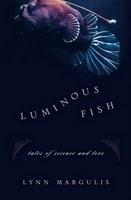Luminous Fish: Tales of Science and Love

This novel by celebrated biologist and writer Lynn Margulis purports to trace the personal lives of scientists. It focuses on four individuals: Howard, a pre-med student at the University of Chicago; Raoul, a French atmospheric chemist; Georges, a New Jersey native and probability expert; and René, the only major female character, at one point involved with Howard and later with Raoul. The final section, “Meeting,” brings all four, as well as several minor characters from earlier chapters, together at a conference.
The goal of Luminous Fish is to portray the everyday lives and conflicts of Margulis’ scientist-characters. In this sense, “Gases” is the most effective, tracing Raoul’s interest in gases from his childhood viewing of the Hindenberg through his professional adult life. We see how his scientific pursuits and obligations form the core of his life, leaving time for little else. In “The Estimator” we learn that Georges’ lack of time-consuming personal relationships has contributed much to his professional success. Even René, learning she cannot have children, reflects that the demands of motherhood would have infringed on her scientific life; her students, she notes, are her children. And Georges’ wife, Odile, must abandon her husband and young son and flee to Argentina to achieve professional success. While these characters are all more-or-less likeable, it is certainly noteworthy that none of Margulis’ main characters have much of a life beyond science.
By focusing solely on these individuals, Margulis paints a rather one-sided picture. There certainly are successful scientists (and lawyers, writers and people in a myriad of other demanding professions) who have many obligations and manage to have a fulfilling personal life as well, often involving marriage and/or children.
Margulis is adept at making you intensely dislike a character and still sympathize with them. For instance, it seems indefensible and cruel that when René visits Paris, her lover, Raoul, keeps her waiting all day and is then too busy with work to spend time with her. However, later we keenly sense his frustration when, on his way to meet her at a conference in Rhode Island, he is delayed by the unexpected hospitalization of his supervisor and forced to stay to hammer out a budget with his colleagues.
In the essay “Sunday with Robert J. Oppenheimer,” which follows the novel, Margulis recalls a 1986 meeting with Phil Morrison, who developed the atomic bomb alongside Oppenheimer, as well as her own encounter with the scientist in 1955. While the questions she asks about the morality of dropping the bomb on unaware civilians in Hiroshima and Nagasaki, balanced against Oppenheimer’s wish to end World War II and prevent future wars, are food for thought, this section seems out of place in this book, as it does not directly deal with the work-life balance (or lack of it) of her fiction. It’s well-written and, with its first-person narrative, more engaging than the rest of the book; it just seems an odd addition to those particular stories.
Luminous Fish is an interesting peek into the world of those who have dedicated (perhaps sacrificed?) their lives to science, but the end effect was to make me grateful for my mundane nine-to-five job and commitments to family and friends.